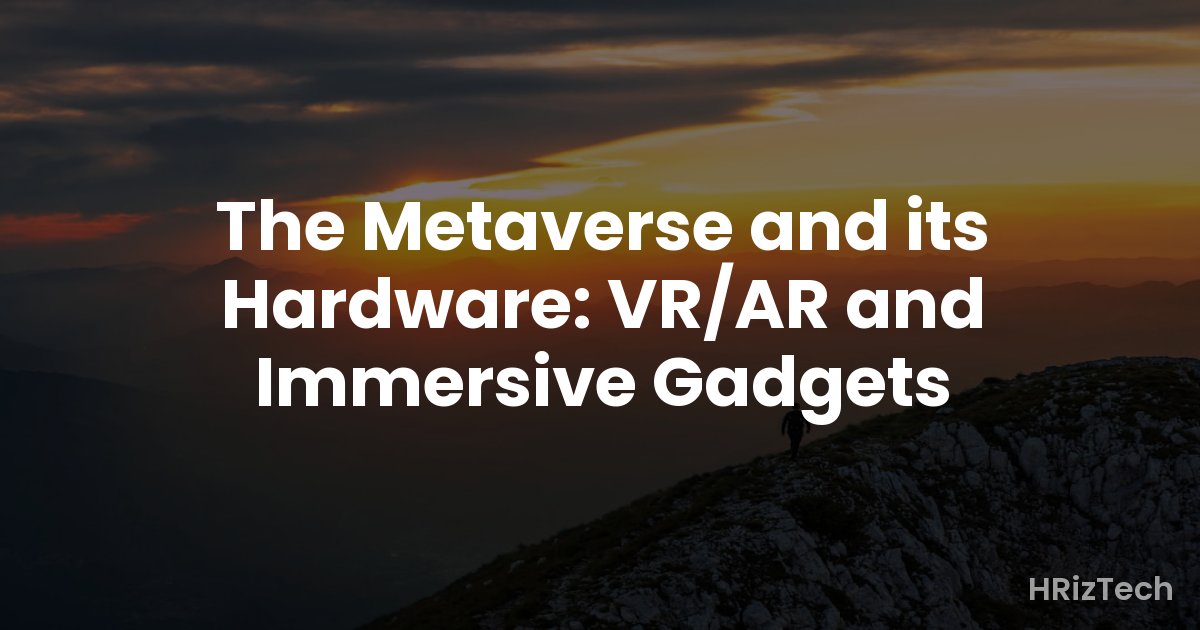The Metaverse and its Hardware: VR/AR and Immersive Gadgets

The Metaverse and its Hardware: VR/AR and Immersive Gadgets
- The Metaverse is more than just hype; it's shaping the future of interaction and experience.
- VR and AR headsets are key gateways to the Metaverse, but other gadgets enhance the experience.
- Choosing the right hardware depends on your needs, budget, and desired level of immersion.
- Haptic feedback and advanced controllers are crucial for realistic Metaverse interactions.
- The Metaverse hardware market is constantly evolving, so staying informed is key.
Stepping into the Metaverse: VR Headsets
The most immediate gateway to the Metaverse is undoubtedly the Virtual Reality (VR) headset. These devices completely immerse you in a digital world, blocking out the physical environment and replacing it with a computer-generated one. The experience can range from simple 360° video viewing to complex, interactive games and simulations. High-end headsets like the Meta Quest Pro offer incredibly realistic visuals and tracking, while more budget-friendly options, such as the Meta Quest 2, provide a great entry point without breaking the bank. However, the level of immersion and comfort can vary significantly. Consider factors like field of view (FOV), resolution, weight, and comfort before making a purchase. A wider FOV provides a more expansive and less claustrophobic experience, while higher resolution translates to sharper visuals. Weight and comfort are critical for extended use; an uncomfortable headset can quickly ruin an immersive experience.
Choosing the Right VR Headset: Key Considerations
When selecting a VR headset, consider these crucial factors:
- Resolution and Refresh Rate: Higher resolution and refresh rates lead to smoother, more realistic visuals. Aim for at least a 4K resolution per eye and a refresh rate of 90Hz or higher.
- Field of View (FOV): A wider FOV provides a more immersive and less confining experience. Look for headsets with an FOV of 110 degrees or more.
- Tracking Accuracy: Precise tracking is essential for realistic interactions within the virtual environment. Consider headsets with inside-out tracking for better mobility.
- Comfort and Fit: A comfortable headset is crucial for extended use. Look for adjustable straps, lightweight designs, and breathable materials.
- Controller Type: The type of controllers significantly impacts the interaction within the Metaverse. Ergonomic, responsive controllers are essential for a smooth experience.
- Price: VR headsets span a wide price range. Set a budget and prioritize features that matter most to you.
Augmenting Reality: AR Glasses and Beyond
Augmented Reality (AR) takes a different approach, overlaying digital information onto the real world. While VR headsets completely immerse you in a virtual environment, AR glasses blend the digital and physical realms, allowing you to interact with virtual objects within your actual surroundings. While the technology is still evolving, AR glasses are becoming increasingly sophisticated. Companies like Apple and Microsoft are pushing the boundaries with their AR/MR headsets, promising a future where virtual objects seamlessly integrate into our daily lives. However, the current generation of AR glasses is often bulky, expensive, and has limited functionality compared to VR headsets. The key to a compelling AR experience lies in seamless integration and intuitive interaction.
The Future of AR: Seamless Integration and Practical Applications
The future of AR lies in creating a truly seamless integration between the digital and physical worlds. This requires advancements in several key areas:
- Lightweight and Stylish Designs: AR glasses need to be comfortable and stylish enough for everyday wear.
- Improved Processing Power: More powerful processors are needed to handle complex AR experiences without lag.
- Advanced Sensors and Tracking: Accurate tracking of real-world objects and user movement is crucial for realistic AR interactions.
- Intuitive User Interfaces: AR experiences need to be easy and intuitive to use, requiring minimal learning curves.
- Wider Applications: Successful AR adoption depends on its practical application in various fields, such as education, healthcare, and entertainment.
Beyond Headsets: Haptics and Other Immersive Gadgets
The Metaverse experience extends beyond just headsets. Haptic feedback devices, such as gloves and suits, add a crucial layer of physical sensation to virtual interactions. Imagine feeling the texture of a virtual object or the impact of a virtual punch – these tactile sensations significantly enhance the realism and immersion. Similarly, advanced controllers, with increased precision and haptic feedback, make interactions within the Metaverse much more natural and intuitive. These peripherals, although often costly, are essential for creating a truly immersive and believable digital experience.
The Evolving Landscape of Metaverse Hardware
The Metaverse hardware market is a dynamic and rapidly evolving landscape. New devices and technologies are constantly emerging, pushing the boundaries of what's possible. Staying informed about the latest advancements is crucial for anyone interested in experiencing the full potential of the Metaverse. Regularly following tech blogs, industry news, and attending relevant events will help you stay ahead of the curve and make informed decisions about your Metaverse hardware investments.
The Future is Immersive: What are your thoughts?
The Metaverse is still in its early stages, but the potential is undeniably vast. What are your thoughts on the current state of Metaverse hardware? What advancements are you most excited about? Share your predictions and insights in the comments below!
Comments
No comments yet. Be the first to comment!